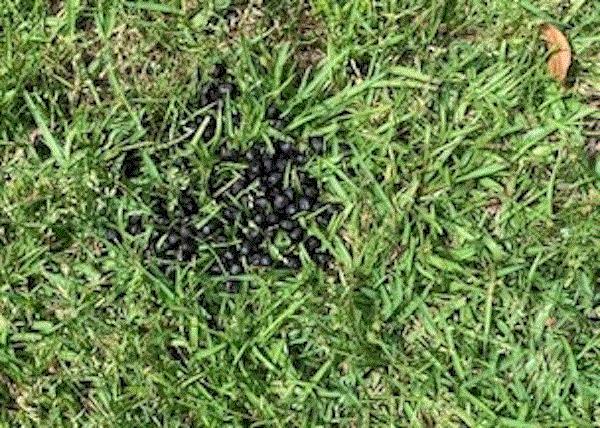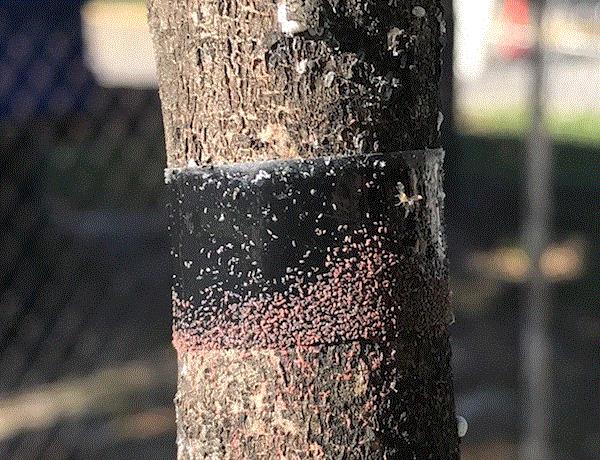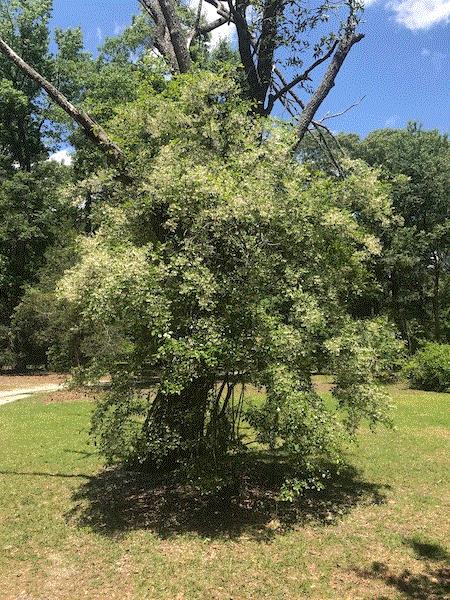What the ... ?
This morning, Keith from Murrell Inlets, South Carolina, sent me an interesting picture. His client took the picture from her centipedegrass lawn, and insisted that those black pellets are tick eggs, according to an article she read online. As a point of reference: the live oak leaf to the right of the black pellets is a little more than one inch long.

This “What the … ?” case is not so much “What in the world are those pellets?” It is, “What in the (expletive) are people putting on the internet?” There are many (expletive) things people put online that others just go about their daily lives believing in wholeheartedly. Perhaps I shouldn't be so hard on those who simply don't know. Part of me feels that I, as an extension educator, didn't do a particularly good job in teaching folks how to weed out bad information. Okay, no more (expletives) for the rest of this issue. Otherwise, I’ll have to move 10 bucks from my bourbon jar to the swear jar. Ouch!
Keith knew better and didn't believe his client. So shouldn't you. What are those black pellets? If you want your name mentioned as the “What the … ?” mystery solver in the next issue of this newsletter, tell me what those are by clicking HERE.

Them scales are about to pop!
Folks must have received a memo with a subject line that read “Send JC pictures today.” Meg Williamson, who heads the diagnostic lab at Clemson University, also sent me a picture of soft scales on a bald cypress twig submitted by a client in Chapin, South Carolina. I think those are Fletcher scales. They could also be tortoise scales, which is Meg’s guess. I’m not entirely sure which species it is since identification can only be done with slide-mounted specimens.

Many soft scale females have gotten fat in my neck of the woods. That makes them more noticeable, so I’m getting more requests for identification in the past couple of weeks. That also means that the females are about ready to lay eggs or the eggs are ready to hatch.
Why should y’all care when crawlers (i.e. hatchlings) emerge? That’s because scale insect crawlers have very little wax on their body, which makes them more susceptible to insecticide sprays. My experiments in the past ten years have repeatedly demonstrated one point: It’s just about impossible to kill the adults with insecticide sprays because the wax layer on their bodies impedes contact between the insect body and the insecticide solution. Adding a surfactant gives better results, but it’s always better to target crawlers. I know I’ve said the same thing many times, but I don't mind sounding like a broken record because I know folks usually retain only 10 percent of what they read and everything is usually forgotten within a month.

You can predict crawler emergence timing based on information from observations and research summarized in extension bulletins, degree-day models or plant phenological indicators. You still have to confirm that crawlers are indeed emerging. That can be done by wrapping a piece of sticky tape around the stem, like what my friend Ted Zee (Clemson University Department of Plant Industry) did when monitoring for crapemyrtle bark scale crawler emergence. (This picture was taken a couple of weeks ago.) Or, y’all can flip over the females and see if there are any eggs or crawlers underneath.
I’m working on an extension bulletin summarizing soft scale insect crawler emergence timing. I’ll let y’all know when it goes live online. I started with soft scales because they are a bit more consistent on emergence timing, as past research of my former graduate student, Dr. Ernesto Robayo Camacho, has shown. Might have to wait a bit on summarizing armored scale information because this group is so large and variable on the number of generations and crawler emergence timing.

What pests does Bt control?
I talked about sawfly on columbine a month ago. Tom of Wilmington, North Carolina, asked if Bt is an option for controlling sawfly.
Bt, as we usually call the bacterium Bacillus thuringiensis, has been used as a biopesticide for controlling caterpillars and some other pests for many years. Bt is pretty common in the soil, but also on leaf surfaces and in insect guts. A Japanese scientist, Ishiwatari Shigetane, first discovered the bacterium in the gut of silkworms in 1901 and named it Bacillus sotto. Ernst Berliner found the same bacterium in 1911 and named it Bacillus thuringiensis. Forty-five years after the discovery, scientists slowly figured out how the bacteria kill their hosts (rotting their guts, basically). Today, many subspecies of Bt (including the subspecies sotto) have been identified and a few of them have been developed into biopesticides.
Now, back to Tom’s question. The answer is no, Bt is not effective against sawfly larvae. One interesting fact about Bt, which can be a double-edged sword, is its specificity. Each subspecies is effective only against a subset of insects. Among the subspecies commercialized as biopesticides, aizawai and kurstaki are specific against caterpillars (Agree, Biobit, Dipel, Leprotec, Thuricide, etc.), galleriae and tenebrionis are for beetles (beetleGone!, grubGone! and Novodor), and israelensis is for fungus gnats and shore flies (Gnatrol). So it’s very important for y’all to pick the right Bt product for the right pests. Can’t just spray willy-nilly and hope the “worm killer” you spray will work against the aphids. Also, Bt works better against young larvae so find the population and treat early.

Three herbicide crop safety summaries
IR-4 has published crop safety summaries for three herbicides—dimethenamid-p, indaziflam and sulfentrazone.
Dimethenamid-p (WSSA 15) is the active ingredient in Tower, and a component in Freehand (dimethenamid-p + pendimethalin). Tower is registered for pre-emergence control of annual sedges, annual grasses and broadleaf weeds in the landscape and nursery. IR-4 conducted 549 trials on Tower between 2007 and 2019 to test for crop safety of over-the-top application. Among the 154 species tested, 65 species were tolerant but 24 species exhibited some injury at two and four times the low label rate (0.97 lb. a.i. or 21 fl. oz. product per acre). Check out the long list of tolerant and sensitive plant species by clicking here. Ten species—Aquilegia, Catharanthus roseus, Cladrastis, Echeveria, Echinacea, Epilobium canum, Muhlenbergia dubia, Rudbeckia hirta, Teucrium chamaedrys and Viburnum opulus—were injured even at the low label rate.
Indaziflam (Marengo and Specticle; WSSA 29) is a pre-emergent herbicide for the management of annual weeds. Two formulations are available—granular or G (0.0224% a.i.) and suspension concentrate or SC (7.4% a.i. but sometimes denoted as 0.622 SC). The G formulation was tested against 34 plant species, with five species (Acuba japonica, Berberis, Liriope, Ophiopogon and Viburnum) exhibiting no injury, eight species exhibiting injury at two or four times the label rate, and six species with significant injury. Read the list of plant species tested by clicking here.
Sulfentrazone (WSSA 14) is the active ingredient of Dismiss, which is used for post-emergence control of yellow and purple nutsedge, as well as several broadleaf weeds. IR-4 evaluated two formulations, G and 4F, but only Dismiss 4F is available to the industry. IR-4 evaluated the crop safety of Dismiss 4F on 65 plant species since 1996. Six species exhibited no injury, seven species had injury at four times the label rate, and fifteen species exhibited some level of injury at all tested rates. For the long list of sensitive species, click here.
Last item for this week is the news that sparkleberry is in full bloom at Back Swamp. That makes lots of bees very happy.






See y'all next time!

JC Chong
Professor of Entomology at Clemson University
This e-mail received by 22,753 subscribers like you!
If you're interested in advertising on PestTalks contact Kim Brown ASAP!